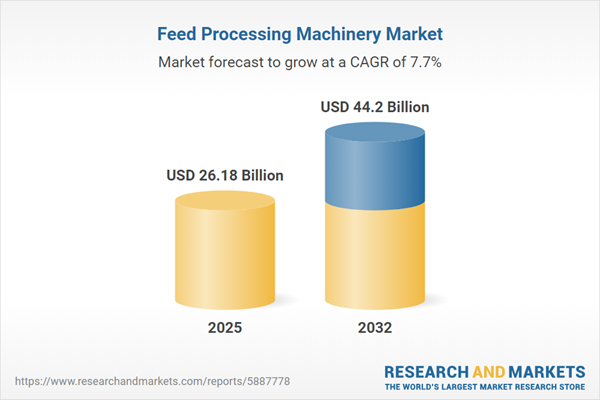Speak directly to the analyst to clarify any post sales queries you may have.
The feed processing machinery market is undergoing a decisive transformation as industry leaders invest in advanced technology and sustainability to streamline operations and remain competitive within strict compliance frameworks. As sector standards progress, senior decision-makers are prioritizing solutions that deliver operational resilience and adaptability.
Market Snapshot: Feed Processing Machinery Market
The global feed processing machinery market is demonstrating resilient growth, supported by strong capital flows into manufacturing advancements and modernization initiatives. Currently valued at USD 24.40 billion in 2024, with projections to reach USD 26.18 billion in 2025 and USD 44.20 billion by 2032, this sector is experiencing a compound annual growth rate (CAGR) of 7.71%. Key drivers include expanding adoption of cutting-edge technologies, increased focus on plant reliability, regulatory compliance, and industry responsiveness to evolving client standards.
Scope & Segmentation of the Feed Processing Machinery Market
This report delivers actionable insights on segmentation to support informed investment decisions and technical advancements in the feed processing equipment market.
- Process Types: Conditioning, extrusion (single and twin screw), grinding, mixing, and pelleting (flat die and ring die) each influence product consistency and quality control.
- Animal Categories: Segments include aquafeed, pet food, poultry, ruminant, and swine, each requiring dedicated equipment to address sector-specific regulatory and performance targets.
- Capacity Ranges: Options span from small-scale systems for niche specialization to industrial-scale solutions, enabling scalability to diverse manufacturing environments.
- Operation Modes: Systems are available in fully automatic, semi-automatic, and manual formats, matching varied workforce capacities and supporting compliance across differing company models.
- End User Profiles: Primary users include aquafeed producers, commercial feed mills, farming operations, and pet food manufacturers, all adopting modular equipment to ensure traceability and agile compliance.
- Regional Coverage: The Americas, Europe, Middle East & Africa, and Asia-Pacific each present distinct adoption patterns, regulations, and strategic requirements for successful collaboration and localized market penetration.
- Technologies Covered: Automation, intelligent controls, predictive maintenance, modular system architecture, compatibility with renewable energy sources, and advanced traceability tools collectively build resilience and operational agility.
- Key Players Analyzed: Industry development is propelled by companies such as Bühler AG, ANDRITZ AG, GEA Group AG, CPM LLC, Amandus Kahl GmbH & Co. KG, FAM Magdeburg GmbH, Henan Zhengchang Machinery Co., Ltd., Zhengzhou Tianci Heavy Industry Machinery Co., Ltd., Fujian Sanfu Machinery Co., Ltd., and Hunan Starke Machinery Co., Ltd.
Key Takeaways for Senior Decision-Makers
- Automation and intelligent process controls deliver stable system performance and vital adaptability to compliance changes in the feed processing machinery market.
- Transparent and modular machinery supports rapid adaptation to customer expectations and shifting regulatory protocols, helping reduce downtime and boost flexibility.
- Digital infrastructure, including remote diagnostics, facilitates swift detection and resolution of operational issues in diverse production settings.
- Customized machinery for specific animal feed segments ensures precise regulatory alignment and allows targeted production adjustments for regional compliance.
- Advanced traceability and allergen detection technology enhance supply chain transparency, which strengthens business accountability and supports regulatory positioning.
- Increasing complexity in technical and legislative environments drives the need for expert knowledge and refined logistical management to safeguard business continuity.
Tariff Impact on Feed Processing Equipment
New U.S. tariffs on feed processing equipment are prompting firms to revise and regionalize supply chains to bolster resilience against trade fluctuations. Industry players are adopting regional sourcing to maintain supply continuity and reduce susceptibility to global disruptions. Integrating additive manufacturing is also enhancing responsiveness, enabling quicker adaptation to regulatory changes and improving logistical efficiency in a rapidly evolving environment.
Methodology & Data Sources
Research combines qualitative interviews with industry leaders and quantitative analysis drawn from authoritative publications, regulatory agency releases, proprietary datasets, and practical case studies. This multi-source approach assures a reliable platform for executive-level decision-making.
Why This Report Matters
- Offers critical, segmented insights for organizations aiming to strengthen efficiency and unlock strategic growth opportunities within the feed processing equipment market.
- Equips leadership with guidance on technical, policy, and digital trends, fostering continuous business operation and readiness for emerging changes.
- Provides practical recommendations for supply chain resilience, advancing sustainability initiatives, and proactively managing risk and compliance needs.
Conclusion
To secure long-term market relevance, organizations must adapt to compliance advances and lead technological innovation. This report empowers decision-makers to navigate evolving sector challenges and cultivate sustained operational success.
Additional Product Information:
- Purchase of this report includes 1 year online access with quarterly updates.
- This report can be updated on request. Please contact our Customer Experience team using the Ask a Question widget on our website.
Table of Contents
3. Executive Summary
4. Market Overview
7. Cumulative Impact of Artificial Intelligence 2025
Companies Mentioned
The companies profiled in this Feed Processing Machinery market report include:- Bühler AG
- ANDRITZ AG
- GEA Group AG
- CPM LLC
- Amandus Kahl GmbH & Co. KG
- FAM Magdeburg GmbH
- Henan Zhengchang Machinery Co., Ltd.
- Zhengzhou Tianci Heavy Industry Machinery Co., Ltd.
- Fujian Sanfu Machinery Co., Ltd.
- Hunan Starke Machinery Co., Ltd.
Table Information
| Report Attribute | Details |
|---|---|
| No. of Pages | 195 |
| Published | November 2025 |
| Forecast Period | 2025 - 2032 |
| Estimated Market Value ( USD | $ 26.18 Billion |
| Forecasted Market Value ( USD | $ 44.2 Billion |
| Compound Annual Growth Rate | 7.7% |
| Regions Covered | Global |
| No. of Companies Mentioned | 11 |









